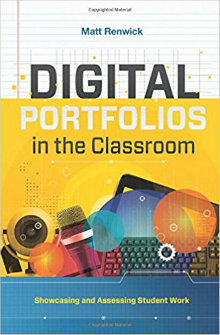Use Digital Portfolios to Showcase Student Work
Digital Portfolios in the Classroom: Showcasing and Assessing Student Work
By Matt Renwick
(ASCD, 2017 – Learn more)

As I read Matt Renwick’s Digital Portfolios in the Classroom, I found myself pausing to explore new tools and websites, revising my lesson plans, or reviewing student work with a new eye.
Renwick’s writing is well-organized and engaging as he works to make a case for digital portfolios. He explores the tools available to facilitate their implementation and to put them into a larger context.
Like most strong educators, Renwick employs an array of strategies to instruct the reader about the implementation of digital portfolios. Personal anecdotes, discussions of technological tools, and interviews with educators and administrators who have implemented digital portfolios provide a multifaceted picture of the benefits and possibilities of digital portfolios.

Sample lesson plans, activities, and rubrics offer further insight. Appendices include a Digital Portfolio Assessment Readiness Tool and Planning Template for Digital Portfolios in the Classroom.
Understanding a variety of platforms
My dad used to call me asking for the CliffsNotes to new technologies, but I have long since ceased to be able to answer him. Though I am certainly computer literate, keeping track of the myriad resources available for digital learning is challenging for me.
Renwick’s chapters Getting Started and Digging Deeper include excellent discussions of different platforms for storing and publishing digital portfolios (blogs, specific applications, and websites) and tools for publishing student work such as screen casting, podcasting, and video creation.
As he explores the benefits and pitfalls of each resource, Renwick encourages readers to choose tools that will best support their purpose in implementing portfolio assessment. Readers with experience using different digital tools might skim this section, though the questions Renwick raises foster deep engagement with the process.
Renwick advocates for a slow and intentional incorporation of digital portfolios: “positive outcomes,” he states “are worth the wait” (p. 130). Part of the work then requires reviewing best practices for assessment (explored in Chapter 1: Defining Digital Portfolios) and curriculum design (Chapter 4: Digging Deeper into Digital Portfolios). Doing so puts the work of implementing digital portfolios into a greater context: “using backward design…teachers ensure that teaching and learning are the priority. Technology is secondary” (p. 96).
Renwick also explores the differences between progress, performance, and process portfolios, highlighting the strengths of each and showing how they can work in concert.
From classroom to schoolwide
Renwick writes for teachers—those of us who will do the daily work of implementing digital portfolios. In the fifth chapter, Going Schoolwide with Digital Portfolios, however, the audience shifts to school leaders. In it, Renwick provides the framework for a successful schoolwide adoption of this assessment system, based, in part, on his own considerable experience as a principal and portfolios advocate.
With examples of digital portfolios in classrooms ranging from grades 1-12, Renwick casts a broad net, and dispels the idea that digital portfolios are appropriate only for older grades. Similarly, he provides examples from a variety of disciplines including math, journalism and elementary education (1st and 2nd grade).
For public schools and beyond
Matt Renwick writes for a public-school audience, acknowledging the dominance of standardized testing in our current assessment culture. However, as a teacher in an independent school, I found the information highly relevant, and perhaps more easily applicable given the absence (or limited import) of standardized testing in many independent schools.
But what about time? Renwick discusses the challenges of implementing digital portfolios in his opening chapter. As he acknowledges, “This more authentic approach to assessment also demands more time and attention” (p.23). I looked for him to return to this concern and offer strategies for making portfolio assessment more efficient. One answer I found is in the structured and cautious approach put forth to administrators for a school-wide implementation.
Perhaps the best response, gleaned as I read Renwick’s work, is that this is vital practice that provides an authentic audience, drives students to create their best work, and places students in charge of their own learning, and is one well worth the time invested to do it well.
Jeny Randall teaches 4th and 5th grade Language Arts and science at Saratoga Independent School in New York State. As Middle School Coordinator, she is overseeing the curriculum and program development for the new middle school. Outside of school Jeny teaches yoga, reads whatever students send her way, and spends time with her family, outside if possible.



































